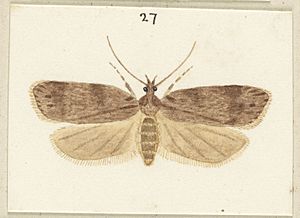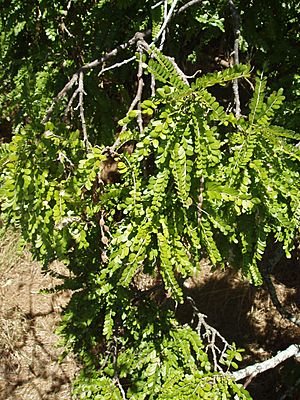Izatha copiosella facts for kids
Quick facts for kids Izatha copiosella |
|
|---|---|
 |
|
| Scientific classification | |
| Kingdom: | |
| Phylum: | |
| Class: | |
| Order: | |
| Family: |
Oecophoridae
|
| Genus: | |
| Species: |
I. copiosella
|
| Binomial name | |
| Izatha copiosella (Walker, 1864)
|
|
| Synonyms | |
|
|
The Izatha copiosella is a type of moth that belongs to the Oecophoridae family. This moth is special because it is found only in New Zealand. You can spot it in the south-eastern parts of the North Island and almost everywhere in the South Island, except for the West Coast.
The young moths, called larvae, live inside dead wood. They probably like to use kōwhai trees as their homes. Adult moths fly around at night and are often drawn to lights. You can usually see them flying during January and February.
Contents
Discovering the Izatha copiosella
This moth was first described in 1864 by a scientist named Francis Walker. He used moths found in Nelson, New Zealand, to study it. Walker first named the moth Gelechia copiosella.
Over the years, other scientists studied this moth more closely. They helped to make sure its name was correct and that it was placed in the right group of moths. For example, J. S. Dugdale and Robert J. B. Hoare later confirmed its current name, Izatha copiosella.
What the Izatha copiosella Looks Like
When the Izatha copiosella moth first lays its eggs, they are oblong (a bit like an oval) and have a pinkish-white color.
The adult moths are usually blackish with some dark grey parts underneath. Their wingspan, which is the distance from one wingtip to the other, is about 15–20 millimeters for males. Females are a bit larger, with a wingspan of 19–23 millimeters.
One special way to tell this moth apart from similar species is by looking at its hind wings. It has a unique patch of yellow scales only in the front half of these wings.
Where the Izatha copiosella Lives
This moth is found only in New Zealand. In the North Island, it lives in the south-eastern areas, starting from Hawke's Bay. In the South Island, you can find it all the way down to Invercargill.
Scientists have collected Izatha copiosella moths in many different places. These include Hawke's Bay, Wairarapa, Wellington, Marlborough Sounds, Nelson, Buller, Kaikoura, North and Mid Canterbury, Otago Lakes, Central Otago, Dunedin, Southland, and Fiordland.
Behaviour and Life Cycle
The Izatha copiosella moths are active at night. They are often attracted to bright lights. Adult moths are typically seen flying during the months of January and February. This species is not considered very common, and scientists have collected only a few female moths.
Habitat and Host Species
The young moths, or larvae, have been found living in dead wood from elm trees. It is also thought that they might feed on dead wood from different types of Sophora trees, which are also known as kōwhai.


